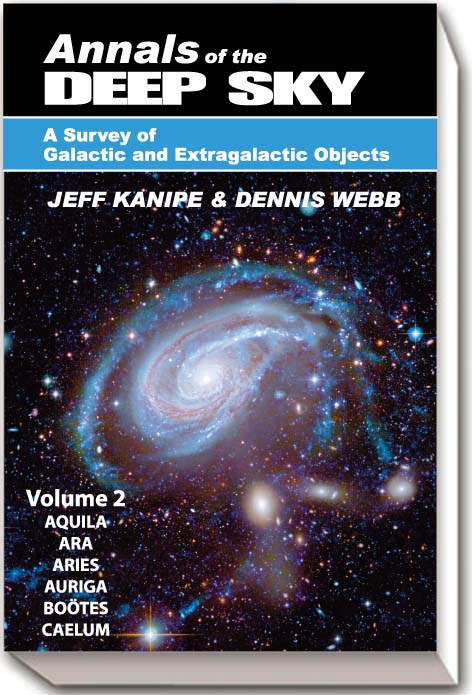Any lover of the night sky knows the value of a good star atlas and an astronomical handbook to guide your exploration of the universe. And while it's true that more information exists out there than ever before online, much of it is intended for a general armchair astronomical audience, or is scattered about the web in disparate places…
But an exciting new series promises to be an essential must for deep sky observers.
Annals of the Deep Sky: A Survey of Galactic and Extragalactic Objects
by Jeff Kanipe and Dennis Webb is a through rundown of the night sky constellation-by-constellation which is aimed at the advanced observer. Mr. Kanipe is a science writer with 35 years experience, and Mr. Webb is a NASA engineer and observer with more than 25 years of experience exploring the night sky. If the names are familiar to deep sky fans, it might be because they also teamed up to produce the
Arp Atlas of Peculiar Galaxies: A Chronicle and Observer's Guide
in 2006. Volumes 1 and 2 covering constellations in alphabetical order from Andromeda to Caelum are out now from
Willmann-Bell, Inc
., and the projected 12 volume set will cover all 88 constellations when completed. Volume 3 is due out in early 2016.
[caption id="attachment_120294" align="alignright" width="330"]
Messier 31 deconstructed by the
Annals of the Deep Sky
. Image credit: NASA/
Willmann-Bell, Inc
[/caption]
Annals
promises to join the ranks of some of the classic sky guides. Observers from the pre-digital era will recall the paucity of good observing resources available just a few decades ago. Growing up in rural northern Maine, even getting our hands on
Sky and Telescope
or
Astronomy
magazine was a daunting challenge, and we often gleaned knowledge of the astronomical goings on for the year from the tables of the
. I remember hearing of the close 0.0312 AU passage past the Earth of
Comet IRAS-Araki-Alcock
in 1983, days
after
it had passed by! Contrast this with today, as message boards and Twitter alert us to new discoveries, sometimes within minutes.
Over the years, Ottewell's yearly
has become a crucial resource as well.
Annals of the Deep Sky
promises to be this generation's answer to
. You have to be of a certain age to remember
Burnham's
, but that landmark three volume guide is one of the few hard copy resources that still resides on our desk well into the digital era. And
Burnham's
has survived despite its use of now outdated 1950.0 stellar coordinates… that's the kind of legendary staying power it has had in the amateur astronomy community!
[caption id="attachment_120295" align="alignnone" width="1000"]
A monument to
Burnham's Celestial Handbook
at the Lowell observatory in Flagstaff, Arizona. Image credit: David Dickinson[/caption]
Annals of the Deep Sky
begins with an outline of how to use the books, and a summary of basic observational astronomy and astrophysics. Like
Burnham's
,
Annals
presents the field of observational astronomy beyond the solar system. But unlike
Burnham's
—which was mainly text—the true magic of
Annals
lies in its extensive use of maps, diagrams and charts, all meant for the serious visual and photographic observer, both in planning observation runs and in the field. These also include some innovative '3-D' style views through the constellations themselves as seen from our Earthly perspective. These views take the observer out through the plane of our galaxy and beyond as we peer out into the universe.
Annals of the Deep Sky
also incorporates the latest discoveries and our understanding of the universe, as well as how our knowledge of astronomy and astrophysics got to where it is today.
Annals
not only provides the visual observer with handy field of view overlays for classic objects such as the Andromeda Galaxy (M31), but it also provides charts depicting camera sensor versus focal length and field of view for DLSR photography of key objects. To our knowledge, no other such resource for this specialized level of information exists for astrophotographers. We also enjoyed the graphic depictions of visual and spectroscopic binary star orbits, another tough item to dig up in research, even with today's modern planetarium programs.
[caption id="attachment_120293" align="alignleft" width="324"]
Representative views of visual (top) and spectroscopic binary orbits.
- Image credit
-
Willmann-Bell, Inc[/caption]
The inclusion of history and astronomical lore is also a great touch that really makes the resource 'pop' in a vein similar to
Burnham's
. This lends a fascinating dimension of astronomical history to the
Annals
that suits to a casual 'shotgun' reading style. Like
Burnham's
, I can see discovering something new from a random opening of the
Annals
for years to come. A fine example is the lingering mystery of the Nova of 1860 in Volume 2 observed by Joseph Baxendell near Arcturus, a fascinating tale we'd never heard of.
We only wish that this awesome resource was also available in digital format so that we could carry this essential reference with us out in the field… we could easily envision cross-referencing information from a laptop planetarium program such as Starry Night or Stellarium at the eyepiece, with
Annals of the Deep Sky
cued up on the Kindle.
So grab that 'Dobsonian light bucket' and the first two volumes of
Annals of the Deep Sky
. This series promises to be an anticipated gem for many years to come. And hey, you can tell the next generation of hipster backyard observers that you remember what it was like
before
we had
Annals of the Deep Sky
to consult!
 Universe Today
Universe Today
